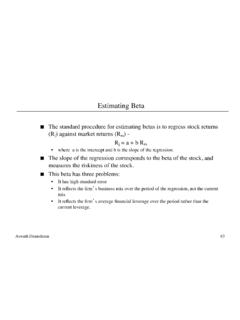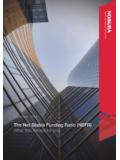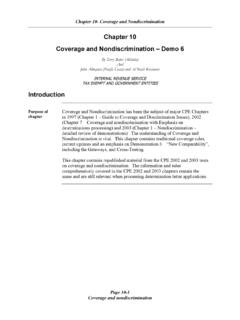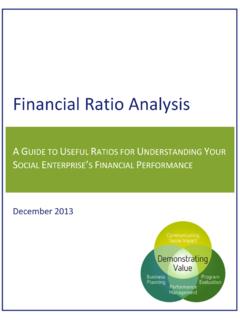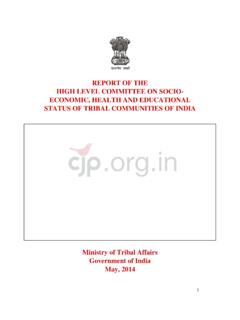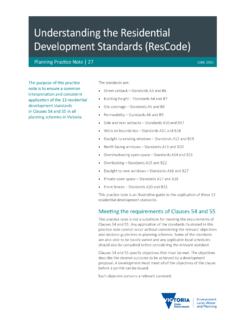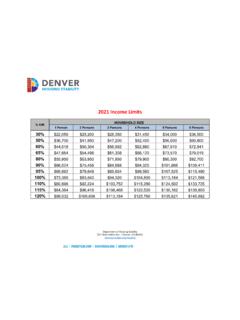Transcription of Weather-Corrected Performance Ratio - NREL
1 nrel is a national laboratory of the Department of Energy, Office of Energy Efficiency & Renewable Energy, operated by the Alliance for Sustainable Energy, LLC. Contract No. DE-AC36-08GO28308 Weather-Corrected Performance Ratio Timothy Dierauf and Aaron Growitz SunPower Corporation Sarah Kurtz National Renewable Energy Laboratory Jose Luis Becerra Cruz Fichtner Evan Riley Black & Veatch Clifford Hansen Sandia National Laboratories Technical Report nrel /TP-5200-57991 April 2013 nrel is a national laboratory of the Department of Energy, Office of Energy Efficiency & Renewable Energy, operated by the Alliance for Sustainable Energy, LLC. National Renewable Energy Laboratory 15013 Denver West Parkway Golden, Colorado 80401 303-275-3000 Contract No.
2 DE-AC36-08GO28308 Weather-Corrected Performance Ratio Timothy Dierauf and Aaron Growitz SunPower Corporation Sarah Kurtz National Renewable Energy Laboratory Jose Luis Becerra Cruz Fichtner Evan Riley Black & Veatch Clifford Hansen Sandia National Laboratories Prepared under Task No. Technical Report nrel /TP-5200-57991 April 2013 NOTICE This report was prepared as an account of work sponsored by an agency of the United States government. Neither the United States government nor any agency thereof, nor any of their employees, makes any warranty, express or implied, or assumes any legal liability or responsibility for the accuracy, completeness, or usefulness of any information, apparatus, product, or process disclosed, or represents that its use would not infringe privately owned rights.
3 Reference herein to any specific commercial product, process, or service by trade name, trademark, manufacturer, or otherwise does not necessarily constitute or imply its endorsement, recommendation, or favoring by the United States government or any agency thereof. The views and opinions of authors expressed herein do not necessarily state or reflect those of the United States government or any agency thereof. Available electronically at Available for a processing fee to Department of Energy and its contractors, in paper, from: Department of Energy Office of Scientific and Technical Information Box 62 Oak Ridge, TN 37831-0062 phone: fax: email: Available for sale to the public, in paper, from: Department of Commerce National Technical Information Service 5285 Port Royal Road Springfield, VA 22161 phone: fax: email: online ordering: Cover Photos: (left to right) PIX 16416, PIX 17423, PIX 16560, PIX 17613, PIX 17436, PIX 17721 Printed on paper containing at least 50% wastepaper, including 10% post consumer waste.
4 I Executive Summary Photovoltaic (PV) system Performance depends on both the quality of the system and the weather. One simple way to communicate the system Performance is to use the Performance Ratio (PR): the Ratio of the electricity generated to the electricity that would have been generated if the plant consistently converted sunlight to electricity at the level expected from the DC nameplate rating. The annual system yield for flat-plate PV systems is estimated by the product of the annual insolation in the plane of the array, the nameplate rating of the system, and the PR, which provides an attractive way to estimate expected annual system yield. Unfortunately, the PR is, again, a function of both the PV system efficiency and the weather.
5 If the PR is measured during the winter or during the summer, substantially different values may be obtained, making this metric insufficient to use as the basis for a Performance guarantee when precise confidence intervals are required. This technical report defines a way to modify the PR calculation to neutralize biases that may be introduced by variations in the weather, while still reporting a PR that reflects the annual PR at that site given the project design and the project weather file. This resulting Weather-Corrected PR gives more consistent results throughout the year, enabling its use as a metric for Performance guarantees while still retaining the familiarity this metric brings to the industry and the value of its use in predicting actual annual system yield.
6 A testing protocol is also presented to illustrate the use of this new metric with the intent of providing a reference starting point for contractual content. ii List of Acronyms AC alternating current DC direct current EPC engineering, procurement, and construction PAC provisional acceptance certificate POA plane of array PR Performance Ratio PV photovoltaic RTD resistance temperature detector STC standard test conditions TMY typical meteorological year iii Table of Contents Introduction: The Performance Ratio .. 1 Variability of PR with Weather .. 2 Theoretical Approach .. 3 Average Annual Cell Temperature .. 6 Calculated Cell 7 Example Data .. 7 Corrected Performance Ratio from Measured Data .. 7 Corrected PR Test Protocol.
7 9 Purpose .. 9 Parties to the Test and Responsibilities .. 9 Requirements Before the Test .. 10 Minimum Irradiance Criteria .. 10 Instrumentation .. 10 Proof of Performance .. 11 Calculation Method .. 11 1. Operating Cell Temperature .. 11 2. Average PV Cell Temperature from the Project Weather File .. 13 3. Calculate the Predicted PV Cell Temperature from Measured Meteorological Data .. 13 4. Temperature-Corrected Theoretical DC Energy Generation .. 14 5. Determine Corrected Measured PR .. 15 6. Compare with Guaranteed Values .. 15 References .. 16 1 Introduction: The Performance Ratio The Performance Ratio (PR) is defined in IEC 61724 [1] and is a metric commonly used to measure solar photovoltaic (PV) plant Performance for acceptance and operations testing.
8 The PR measures how effectively the plant converts sunlight collected by the PV panels into AC energy delivered to the off-taker relative to what would be expected from the panel nameplate rating. This metric quantifies the overall effect of losses due to: inverter inefficiency, wiring, cell mismatch, elevated PV module temperature, reflection from the module front surface, soiling, system down-time, shading, and component failures. Because many of these factors are indicators of build quality, this metric is popular with some companies and financiers for contractual acceptance testing. However, some of these factors are also weather dependent. Most notably, weather affects the PR by affecting the module temperature. To many financiers, this is an attractive feature of the metric because it helps to understand which locations will provide the most productive plants.
9 For example, a colder site will provide a higher PR, implying more electricity generation if everything else is equal. Unfortunately, associated with this dependence on the weather is a bias error in the metric that introduces unnecessary risk in contractual acceptance testing. The PV system electrical output changes as weather varies; for example, system output changes with temperature (typically ~ C), irradiance (typically can vary by as much as 5% 10%, especially for modules with high shunting or series resistance), and spectrum (typically varies by up to ~3%, depending on the difference in responses of the irradiance sensor and the PV module). As shown in Figure 1, the PR can swing radically over a single day. The contract must specify a PR that is representative of the annualized Performance at the site, but the season of the measurement is seldom defined, leading to unnecessary risk for both parties.
10 Before proposing a method for reducing this risk, we give some background on PR. PR values for new systems typically range from to [2-9] . A recent paper summarizing the Performance of ~ 100 German PV systems concluded that the cool climates in Germany helped some systems approach, or even exceed, [2]. The strong dependence of PR on temperature results in a large seasonal variation in PR, which can be as large as 10% [3-6, 9]. PR is often corrected to a common temperature of 25 C (standard reporting conditions) [4, 5]. Correction to a cell temperature of 25 C usually results in a higher PR because modules more frequently operate at 45 C. Thus, while correction to 25 C essentially solves the problem of seasonal variations, it may overstate the actual Performance and thus does not allow the financier to assess the effect of local climate on the expected Performance .










